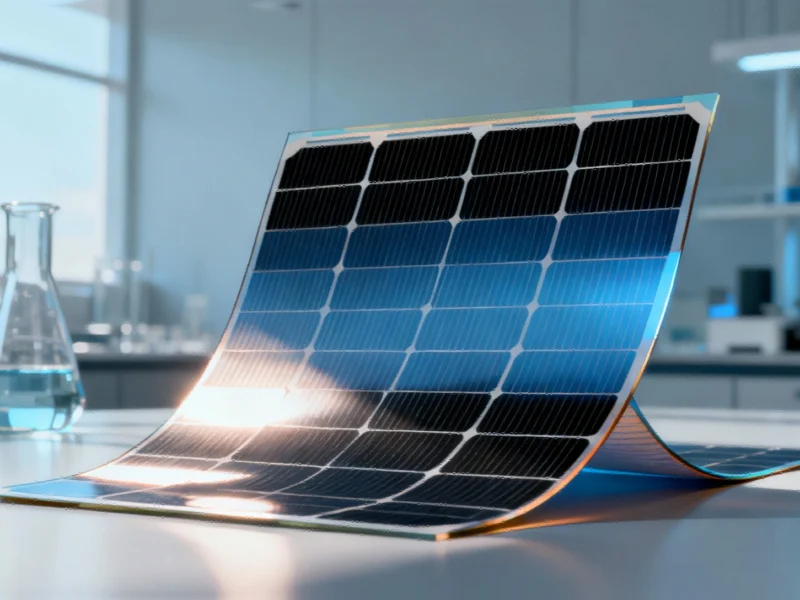European Consortium Accelerates Next-Generation Solar Technology
The Horizon Europe PEARL project is transforming solar energy development through innovative flexible perovskite solar cells with carbon electrodes, achieving remarkable progress toward commercialization targets. This ambitious initiative represents a significant advancement in renewable energy technology, particularly as European consortium advances flexible solar technology with groundbreaking efficiency and stability improvements.
Perovskite materials have emerged as a promising alternative to traditional silicon solar cells due to their exceptional light absorption properties, material abundance, and potential for low-cost manufacturing. While silicon cells dominate the current market, they require energy-intensive fabrication processes, whereas perovskite cells can be produced using cost-effective roll-to-roll techniques suitable for flexible, lightweight applications.
Strategic Collaboration Driving Innovation
The PEARL consortium brings together ten specialized European partners representing academic institutions, research organizations, and industrial enterprises. This collaborative approach ensures comprehensive expertise across the entire development chain, from fundamental materials research to industrial-scale manufacturing.
University of Rome Tor Vergata leads the development of high-efficiency flexible cells and modules using advanced deposition techniques, working closely with Fraunhofer FEP, Institute of Chemical Research of Catalonia, and Helmholtz Centre for Materials and Energy. The university team is simultaneously optimizing module designs to minimize efficiency losses during scaling.
The University of Applied Sciences Northwestern Switzerland contributes critical sustainability analysis through Life Cycle Assessment and develops recycling protocols for photovoltaic materials, ensuring environmental responsibility throughout the product lifecycle.
Manufacturing Breakthroughs and Efficiency Gains
At the project’s midpoint, researchers have achieved solar cells with over 21% efficiency on flexible PET substrates – a significant milestone toward the ultimate 25% target. The manufacturing partners have successfully scaled up production processes, with VTT and TNO developing flexible minimodules covering 36cm² with 4.5% power conversion efficiency using their pilot-scale roll-to-roll infrastructures.
Fraunhofer FEP’s vacuum-based coating infrastructure enables production of flexible transparent electrodes and barrier foils, while Dycotec Materials provides specialized carbon inks, barrier adhesives for encapsulation, and antireflection coatings. These manufacturing advancements come as Western Cape solar expansion accelerates amid corporate investment in renewable infrastructure worldwide.
Enhanced Durability and Real-World Performance
Durability has been a historical challenge for perovskite solar technology, but the PEARL project has made substantial progress. The consortium has developed protective encapsulation that maintains solar cell stability for over 2,000 hours under demanding damp-heat conditions (85°C temperature and 85% humidity).
Energy company Eni is conducting comprehensive performance testing using both indoor and outdoor facilities to assess energy yield under realistic conditions. This rigorous testing approach ensures the technology will perform reliably in practical applications, addressing concerns that sometimes emerge when regional banking sector jitters return amid loan defaults affect technology investments.
Sustainability and Environmental Impact
Sustainability remains a core focus throughout the PEARL project. Initial life cycle assessments demonstrate that incorporating carbon electrodes, recycled PET substrates, and green energy sources can reduce the carbon footprint by more than 50% compared to conventional solar manufacturing.
The project has also developed innovative processes to recover valuable materials like lead and cesium from production waste, creating a more circular economy for photovoltaic manufacturing. These environmental considerations align with growing industry trends where Windows 11 Copilot gets voice activation and screen analysis features that optimize energy usage in computing systems.
Commercial Applications and Market Potential
The flexible nature of PEARL’s perovskite solar cells opens numerous commercial applications beyond traditional solar panels. Building-integrated photovoltaics, Internet of Things devices, portable electronics, and curved surfaces all represent potential markets for this technology.
As Dr. Riikka Suhonen, PEARL Project Coordinator at VTT, emphasized: “These achievements bring us firmly within reach of our 25% target – paving the way to low-cost, high-performance solar modules for applications from building-integrated photovoltaics to the Internet of Things.” This progress is particularly significant as industries recognize that affordable financing and supplier vetting are key to successful technology deployment.
Future Development and European Leadership
As the project enters its final phase, researchers will focus on optimizing roll-to-roll manufacturing processes, testing larger modules for outdoor applications, and publishing comprehensive life cycle assessment results. The deliverables will include optimized module design specifications, encapsulation processes, and pilot-scale production protocols that position Europe as a global leader in flexible perovskite photovoltaic technology.
The PEARL project represents a crucial step toward making flexible, efficient solar technology commercially viable, potentially transforming how we generate and integrate renewable energy across multiple sectors. With continued progress, these advancements could significantly impact global energy markets and accelerate the transition to sustainable power generation.
Based on reporting by {‘uri’: ‘innovationnewsnetwork.com’, ‘dataType’: ‘news’, ‘title’: ‘Innovation News Network’, ‘description’: ”, ‘location’: None, ‘ranking’: {‘importanceRank’: 1000000}}. This article aggregates information from publicly available sources. All trademarks and copyrights belong to their respective owners.



